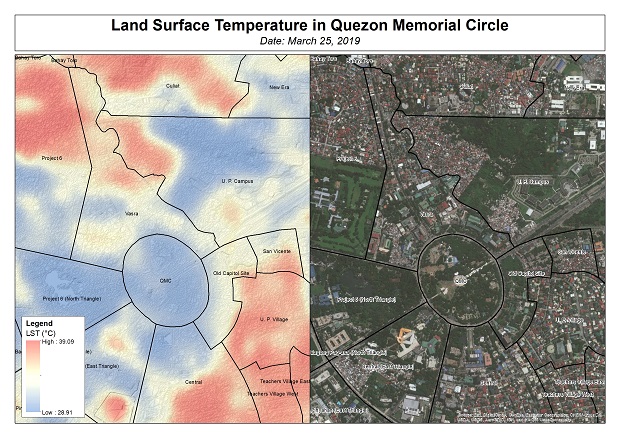To find ways to mitigate the harmful effects of the rising temperatures in urban areas, the government is assessing the development of urban heat islands in rapidly urbanizing and highly urbanized cities in the Philippines using satellites and modeling-simulation techniques.

The initiative is being led by the Department of Science and Technology (DOST), through the Philippine Council for Industry, Energy, and Emerging Technology Research and Development (PCIEERD), and the University of the Philippines-Training Center for Applied Geodesy and Photogrammetry (UP-TCAGP).
Dr. Ariel Blanco, project leader of Project GUHeat or “Geospatial Assessment and Modelling of Urban Heat Islands in Philippine Cities,” said they will harness the power of thermal images from satellites to help the government “minimize the warming of urban areas or urban heat islands (UHIs), and even reverse it to decrease electricity consumption and air pollution, reduce health risks and diseases, that will result to greater livability of our cities.”
Project GUHeat will develop geographic information system-based methods and tools to map, model, and characterize UHIs that are easy-to-use by local government units which can be accessed through a Web-based GIS.
To date, they are studying and evaluating the land surface temperature (LST) of Quezon City, Baguio City, Cebu and Mandaue City, Iloilo City, Zamboanga City, and Davao City using satellite imageries in order to assess the effect of urban heat islands.
The project also aims to build and enhance the capacity of LGUs in incorporating thermal environment conditions in planning and development towards the attainment of UN Sustainable Development Goal.
“I’m happy to share that these local government units (LGUs) are very enthusiastic and supportive, and shall utilize the project outputs in revising plans and implement measures to reduce urban heat islands (UHIs),” Blanco shared.
A city experiences an urban heat island effect when it has warmer temperatures than nearby rural areas. The materials used in the construction of buildings and establishments and the lack of trees and vegetation affect the distribution and persistence of heat in a city.
Warmer temperatures increase energy consumption, emissions of air pollutants and greenhouse gases, impair water quality, and compromise human health and comfort.
DOST-PCIEERD deputy executive director and officer-in-charge Raul C. Sabularse expressed hope that project will positively contribute towards climate change adaptation.
“It is imperative that local government units plan and strategize using the GIS-based maps and models that will be developed through Project GUHeat for the thermal comfort of Filipinos,” Sabularse said.
Blanco said they intend to use unmanned aerial systems (UAS) that have thermal cameras to thoroughly map and determine the changes of land surface temperature (LST) over time.
His team will also laser-scan the cities involved in their project to produce 3D models for simulation. Through simulation, they will be able to explore possible scenarios and be ready with urban-heat-mitigating measures.
(This was originally posted at Newsbytes.ph on July 10, 2019.)
